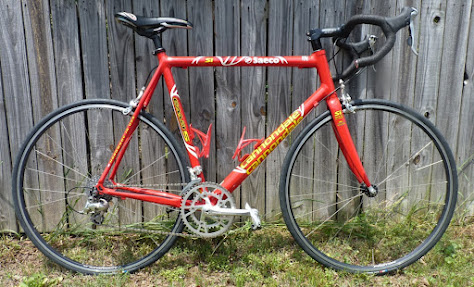 |
| Who knew, Henry also loves the Giro? |
I'll admit that I wasn't too excited about the condition of the trail's paving back then, as there were so many roots pushing up the asphalt, it felt like riding over an old washboard! The trail forms a 22-mile crescent - very appropriately, because his ship was named Halve Maen (half moon) - counterclockwise from Atlantic Highlands to Freehold. See the map below for reference.
Because the day before I had done a ride of 30 miles and nearly 3000 feet of climbing with my friend Mike, I wasn't looking for a huge quantity of pedaling, maybe just a casual out and back along the water. I would just be riding the first two miles of the Bayshore section of the trail and then I planned to check out Sandy Hook, completing about a 24-mile circuit.
It turns out I received much more of a workout than I expected, due to the winds coming off the ocean and the HILLS! There is a reason the area is called the Atlantic Highlands, which were a real grind on the return leg, and the crossing of the steep bridge over Highlands Reach was a real leg-burner. This span allowed the passing below of sailboats from the marinas that dot the Navesink River and Shrewsbury Bay.
The Henry Hudson Trail weaved around through the development along Sandy Hook Bay, and unexpectedly became an unpaved path. It probably wouldn't have been too bad if it hadn't rained the day before, and there was some runoff from nearby parking lots and driveways. The mushy-ness led to my decision to return on Memorial Parkway (Route 36) instead.
 |
| Once clear of the developments, the trail was quite pleasant. |
 |
| The complete Henry Hudson Trail (in red) |
Just after the cloverleaf at the bridge, I moved onto the wonderful asphalt trail that wound through the scrubby woodlands up along Sandy Hook. I was having a blast zipping along the nearly perfect (some spots of wind-blown sand, but not treacherous) surface, which even had a couple little rises and falls among the trees.
I hadn't done a whole lot of research about where I was headed, and I was surprised by the somewhat spooky surroundings of Fort Hancock. I'll leave you to read up on its history, but since the site was decommissioned in 1974, the attractive yellow brick houses along Officer's Row had fallen into disrepair. Some restoration to the buildings has commenced and alternative uses are being investigated. I think I got such a creepy vibe because the area is mostly uninhabited and there are few trees or bushes to improve the landscape.
 |
| Sandy Hook Lighthouse |
I was pretty wasted from fighting the wind by the time I reached my second crossing of Highlands Reach, but when I finally crested the bridge, I was treated to a nice view of the Navesink Twin Lights:
The bike pick-up to which I had referred was a 2002 Cannondale R2000 Si, in the Saeco/Cannondale team colors. I used to have a similar R700, which came with lower quality stock components, but I unloaded that about a decade ago, when I upgraded to my SuperSix 5.
I got into a conversation with a friend about Mario Cipollini and the Saeco team. I mentioned owning that Cannondale, with which I did a couple century rides, and I remembered receiving compliments about the bike. I then came across the blog entry about buying that bike while searching for some other information. I really missed that bike, did a casual search on Facebook Marketplace and found one in gorgeous condition.
 |
| The image from the listing - why do people take photos of the wrong side of the bike? |
The stock R2000 Si came with Ultegra components, a carbon fork manufactured by Time and, strangely, a set of Campagnolo Proton wheels. The owner had upgraded the bike further by installing a 3T cockpit and a Selle Italia saddle. It was at a great price, and I'm not sure what I'm going to do with it in the long run, but I couldn't pass it up!
Although I had brought my SuperSix with me, just in case, I had the intention of taking the R2000 on a test ride. I had also brought along a set of Look pedals and some tools so I could install them, and I also wanted to flip the stem around from that unsightly upward position. Unfortunately, after a couple turns to retighten the bolts (there are only two on the faceplate of the 3T "Zepp" stem), there was a pop sound and the bolt spun around freely, obviously now stripped.
I quickly came up with the idea of swapping in one of the stem bolts from the SuperSix, but they turned out to be the wrong length. I didn't want to get bent out of shape over a little piece of hardware that could easily be replaced by something in my parts bin, so I jumped on my SuperSix for the ride to Sandy Hook.
There were a few things I wanted to change up, most importantly installing a wider range cassette and a compact crankset to give the bike better "climbability". I opted for the interesting Sakae/Ringyo CR cranks, which have a web and rings that have a cool spiral shape. I swapped out the seatpost that had a setback of a couple centimeters to a straight Cannondale post. Finally, although the Elite Ciuzzi bottle cages are a classic, I didn't like the yellow and opted for some sleek, modern red Blackburn versions.















